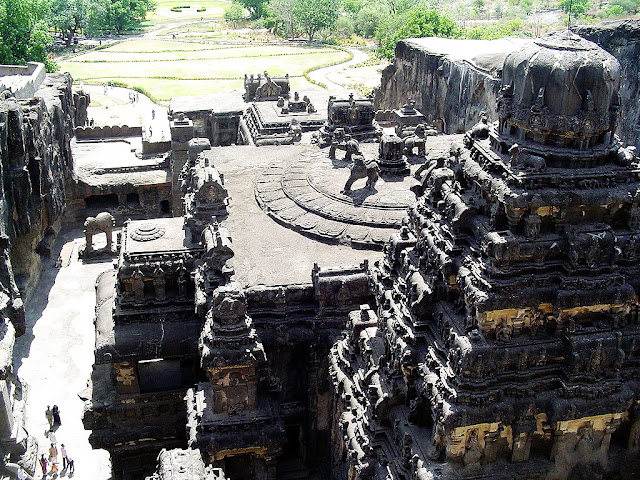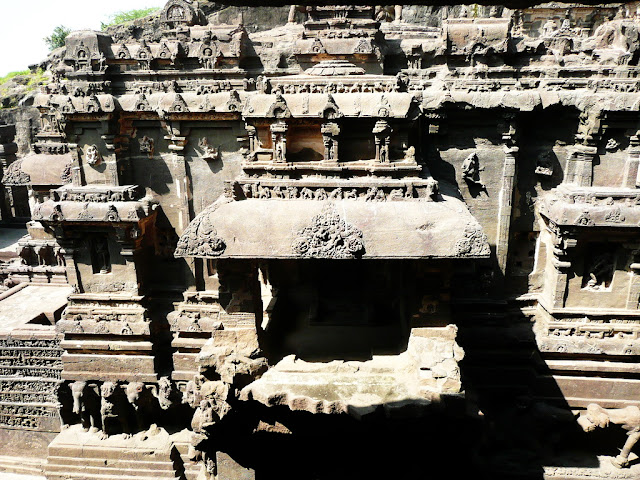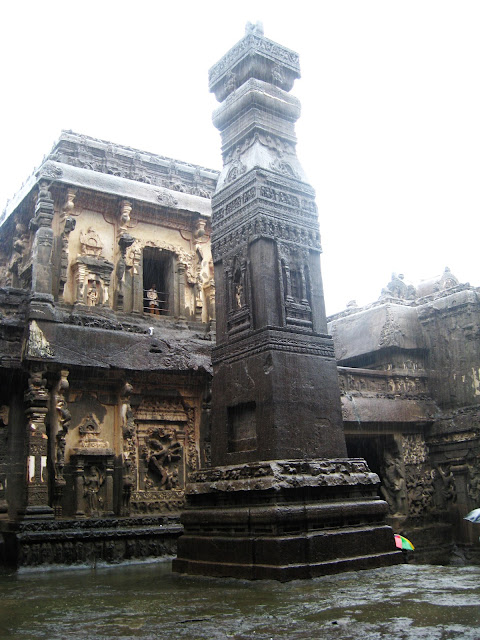Sunt subiecte despre care nu vrei sa vorbesti, sau altele despre care ai vorbi mereu. India este unul din marile mele si de suflet subiecte. Despre ce este azi INDIA,
am scris aici: O noua atitudine, Link:
... India, o superputere economica, IT, nucleara, militara, spatiala etc. etc. ...
Un DOCUMENTAR foarte bine realizat, apreciat de cititorii mei.
Pozitia 1 in Top 10, cele mai citite postari.
===================
Azi insa, revin aici cu un alt subiect de top:
India este si "casa" zeilor!
Ellora Cave 16 – Kailasanatha Temple.
Kailasha Temple. Kailasa Temple. Kailash Temple
El este super-puternicul zeu Shiva.
Nu despre el vom discuta, ci despre una din "casele" lui:
Ellora Cave 16 – Kailasanatha Temple.
Kailasha Temple, Ellora
It is believed that the construction of the Kailash Temple was started in the mid 8th century under the direction of King Krishna I (757-775) of the Rashtrakuta dynasty.
This temple is world's largest monolithic structure carved from one piece of rock and the most extensive rock-cut projects ever undertaken.
Kailash Temple is situated near the village of Ellora, 30 km from Aurangabad.
The temple is considered as one of the most astonishing buildings in the history of architecture. This is one of the largest 34 excavations at Ellora, which took almost a century. Kailash Temple is dedicated to Lord Shiva.
The idol measures 109 feet wide by 164 feet long.
**********************
It is estimated that it took about 100 years to complete the work.
Kailash is the biggest monolith in the world, made of one piece of rock.
********************************
Ellora represents the epitome of Indian rock-cut architecture.
The 34 "caves" – actually structures excavated out of the vertical face of the Charanandri hills. Buddhist, Hindu and Jain rock-cut temples and viharas and mathas were built between the 5th century and 10th century. The 12 Buddhist (caves 1–12), 17 Hindu (caves 13–29) and 5 Jain (caves 30–34) caves, built in proximity, demonstrate the religious harmony prevalent during this period of Indian history.
====================
=============
Ellora este un sat din statul Maharashtra la 30 km nord-vest de orașul Aurangabad, India. Satul a devenit renumit prin templurile-grotă, mănăstirile și capelele care se află la 2 km sud-est. Templurile săpate în stânca de bazalt, datează din perioada dintre secolele V și X și au fost declarate în anul 1983 patrimoniu mondial UNESCO. Construcțiile religioase au fost numeroate de la sud-est la nord-vest, între numerele 1-12 sunt budiste și datează din anii 400-800, iar cele hinduse aparțin de grupa de numere 30-40 și datează din anii 600-900. Există și o grupă ce aparține de religia iainistă ea datând din anii 800-1000. Un element care trebuie amintit sunt coloanele Amalaka ce au un capitel în formă de pepene. Cele mai multe încăperi sunt împodobite cu sculpturi.
Ellora
De la Wikipedia, enciclopedia liberă
=============
===========================
Ellora Cave 16.
Kailash Temple, ramane inca o uriasa enigma!
Nu impartasesc punctele de vedere oficiale, dar nu cred ca aceasta este important.
Oamenii deseori, din motive greu de cunoscut, refuza a cauta, cunoaste adevarul!
Prefera surogatele, minciuna. Sa fie asta calea? Poate da, poate nu!
Admin
=======================
=========================================================
================================
==============================================================



























































Daca ti-a placut, te rog distribuie mai departe!
RăspundețiȘtergereCu cat vom avea mai multi prieteni, cu atat sansele de a salva pretioasele artefacte, geofacte sunt mai mari! Opinia publica poate deveni Forta nr.1, intr-o lume a guvernarilor bezmetice, iresponsabile! Ia si tu, atitudine!
Multumesc pentru intelegere!
Kailash Temple Maharashtra.
RăspundețiȘtergere==========================
At ELLORA , 34 cave temples were carved out of the hillside with hand tools. Only 12 of these 34 caves in the centre are the most impressive. The massive Kailash Temple (cave 16) is nearly one a half times taller than the Parthnon and occupies almost twice its area. It is believed that it was constructed by excavating approx. 200,000 tones of rock and is possible the world's largest monolithic structure. Representing Shiva's Himalayan home, the temple is exquisitely sculpted with scenes from Hindus mythology, each pulsing with drama, energy and passion. The Kailash Temple situated near the village of Ellora. It is considered as one of the most astonishing 'buildings' in the history of architecture.
This temple is the world's largest monolithic structure carved from one piece of rock and the rock - hewn temples and monasteries of Ellora that lies just 30 kms from Aurangabad.. Kailash Temple at cave 16, were a big Shiva-linga (form of Lord Shiva) is worshiped. It is the biggest building carved in a stone in the whole world. is a part of Ellora Cave Complex. The Kailasanatha temple is the world's largest monolith structure that was literally scooped out of the hill side. Lord Shiva is worshipped in the form of a giant lingam in the garba griha. Beautiful sculptures from Ramayana and Mahabharatha are carved on the walls of this cave temple.
Kailash Temple Maharashtra.History.
RăspundețiȘtergere==========================
The depiction of the demon Ravana shaking Mount Kailash is a masterpiece contain the scenes of semi-mythological history, the royal court and popular life of the ancient times, as told in romances and plays. Some pictures recall the Greek and Roman compositions and proportions, few late resemble to Chinese manners to some extent. But majority belongs to a phase which is purely Indian as they are found no where else.
These monuments were constructed during two different periods of time separated by a long interval of four centuries. The older ones were the product of last to centuries before Christ and belongs to Hinayana period of Buddhism in later part of 2nd century AD when Buddhism was divided into two sections, after the conduct of the fourth general council under another great king, Kanishka.
The new feature of Mahayana Buddhism was the concept of future Buddha's. The Buddha, himself probably thought that he was the last of the long succession of earlier Buddha's who lived before him. According to the Buddhist traditions, these former Buddhas were revered even in the historical Buddha's lifetime.
By the time king Ashoka, their cult was widespread and was patronized by Ashoka. Later, when the stupas were constructed and beautified, the carvings were executed in a symbolic way. An inspired sculptor began to carve images of Buddha himself and within the few generations, all the Buddhist sects took to worshipping images.
The universe of Mahayana contains numerous Bodhisattava, the chief of whom is Avalokitesvara with attributes of compassion. He is also called Padmapani or the lotus bearer. The Manjushri with a naked sword in one hand, stimulates the understanding. The sterner Bodhisattava who is a foe of the sin and evil and bearing a thunderbolt in the hand is Vajrapani. The future Buddha, Maitreya will take birth to save the world.
Kailash Temple Maharashtra.Architeure
RăspundețiȘtergere==========================
It is believed that work on the Kailasha temple was begun in the mid-8th century and under the direction of King Krishna I (757-775) of the Rashtrakutadynasty, the rulers of the western Deccan area. One of the India's greatest architectural treasures, was hewn out of the solid rock of the hillside to form a free-standing temple consisting of a gateway, two-storied halls and the main shrine within.
The most majestic creation is the Kailash Temple, a full-sized freestanding temple flanked by huge elephants all carved from solid rock, pillars and pondiums, as the workers dug away some 200,000 tons of rock.
The result is an awe-inspiring representation of Shiva's Himalayan abode. Nearby caves are alive with stone murals depicting divine struggles and victories. With these caves before us, it is clear that India far surpasses the rest of the world in the glory of its rock-cut architecture.
Stiti cum vad eu Kailash Temple ?
RăspundețiȘtergerePrecum niste nave spatiale!
Priviti atent... "masinariile",
incapsularea acestora! Gata de zbor!
Ori ... abia au aterizat!
Cu multe milioane ani in urma!
Hmmm.... dar oficial... este altceva!
Bieti oameni, cu unelte primitive... cum au dantelat stanca, bazaltul!?!!
Cel mai mare, urias MONOLIT din lume! Hmmm... credeti voi, eu nu!
Inca un set de enigme:
Ștergere=====================
Dantelaria sculpturilor de pe peretii interiori, in cel mai profund, desavarsit si "negru" ... INTUNERIC, fara "pereti afumati" si "scule electrice cu varf de diamant", cum a fost posibila? Cine a realizat si cum picturile, sculpturile uriase care intrunesc in totalitate regulile artei moderne? Cum? Cine?
Bietii oameni/calugari ai anilor 700-800 e.n.?
Salut, Vasile! Fabuloase imagini, fabuloase realizări! Nu-ti vine să crezi că mâna omului, cu tehnica specifica secolului 8, după Christos a putut realiza asemenea capodopere.
RăspundețiȘtergereVictore, te salut!
ȘtergereAi dreptate, realizari fabuloase!
Nici eu nu cred ca sunt realizate de "mâna omului, cu tehnica specifica secolului 8, după Christos"! Dar ce cred eu, nu se "coase la dosar"! Sunt un biet anonim, un calator pe net!
Complexitatea si frumusetea acestor opere de arta - temple sau indiferent ce nume inca mai poarta - depaseste posibilitatile mele de intelegere! Cred cu tarie ca "oamenii" acelor timpuri, nu au avut nimic comun cu "constructiile" acestea! Poate o data si o data, vom afla despre ce si cum a fost in acele vremuri de glorie ... non-umana!
RăspundețiȘtergerePe mine altceva ma preocupa:
Ștergere========
La ce au servit in momentul darii in folosinta si in perioada imediat urmatoare? Imi este clar ca peste mii si mii de ani, milioane poate, oamenii le-au preluat si adaptat nevoilor lor spirituale, religioase! Dar inainte?
Ellora Caves:
RăspundețiȘtergere============
Ellora Caves (Maharashtra) belong to the highest achievements of mankind both regarding the engineering skills and arts. Words can not describe the incredible richness of artistic and phylosophical messages emanated by thousands of sculptures, drawings and inscriptions in Ellora.
This group of 34 monasteries and temples belongs to the last great cave temples of India. Temples were built for three religions - 12 Buddhist temples and monasteries (630 - 700 AD), 17 Hinduist shrines (550 - 780 AD) and 5 Jain temples (800 - 1000 AD).
Most amazing creation here is Kailasanatha (Kailash Temple). This is large (84.1 m long and 29,3 m high - two times larger than Parthenon in Athens), free standing structure with extremely complex structural planning. It was carved 100 years and in this time with extreme precision were removed 200,000 tonnes of rock. Temple was shaped to resemble the sacred Mount Kailash and originally was plastered and painted in bright colors.
Some more cave temples here represent amazing achievement of structural engineering and contain important art values of global importance - Cave 10 ("Carpenters Cave"), Cave 11 (Do Tal) with three stories, Cave 15 (Dasavatar), Cave 21 (Rameshvara), the amazing Cave 30 (Chhota Kailash - a smaller version of Kailasanatha) and the extremely ornate Cave 32 (Indra Sabha). - thanks,admin Romania megalitica! -
Wowwww...
ȘtergereThe caves aren't natural caves, but man-made temples cut into a massive granite hillside. They were built by generations of Buddhist, Hindu, and Jain monks, who lived, worked, and worshipped in the caves, slowly carving out elaborate statues, pillars, and meditation rooms.
-----------------------
... but man-made temples cut into a massive granite hillside. ......
Ha, ha, ha .............